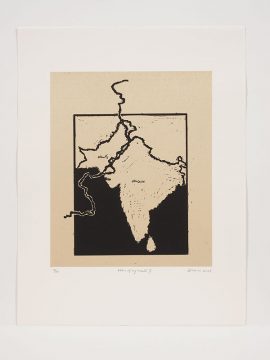From Art Radar:
 In a short video documentary produced by the Tate Modern in London, the artist talks about her exhibition, “Letters from Home,” which opened on 28 March 2013. Through personal letters, the exhibition illustrates an immigrant’s disconnection from his or her homeland. In the Tate video interview, Zarina discusses how working with letters from her sister, Rani, has helped her to preserve her sense of identity. “It’s almost like writing your life’s story, and it’s not just my life’s story. It’s the story of all immigrants. And that’s where the home comes in, the idea of home, and maps and floor plans,” she says. “I just made my personal life the subject of my art, so I have to write about what I have gone through”.
In a short video documentary produced by the Tate Modern in London, the artist talks about her exhibition, “Letters from Home,” which opened on 28 March 2013. Through personal letters, the exhibition illustrates an immigrant’s disconnection from his or her homeland. In the Tate video interview, Zarina discusses how working with letters from her sister, Rani, has helped her to preserve her sense of identity. “It’s almost like writing your life’s story, and it’s not just my life’s story. It’s the story of all immigrants. And that’s where the home comes in, the idea of home, and maps and floor plans,” she says. “I just made my personal life the subject of my art, so I have to write about what I have gone through”.
The video juxtaposes images of New York, where Zarina has lived and worked since 1973, with the Urdu-inscribed prints that illustrate both her physical and emotional journeys. The first artwork in the video is a detail of Atlas of My World (2001), in which a jagged black line separates India from Pakistan. “I really don’t have a family in India,” Zarina notes. She states that the significance of her family’s forced move from India to Pakistan, a result of the 1947 Partition, was not something that she fully comprehended until many years later.
Zarina’s style derives from the blending of cultures that she has experienced in her travels and studies. She completed a degree in Mathematics in 1958, but soon fell in love with printmaking. After training in woodblock printing in Bangkok and Tokyo, Zarina also studied intaglio in Paris. In Zarina’s workspace, bits of paper, covered in Urdu and cut into geometric strips, await placement in her various artistic projects. The plywood engravings she has used in the printmaking process are seen at her workbench. The softness of the wood is what attracted Zarina to the medium: “I just like the texture of the wood; I like the way you dig in.”
Zarina often uses writing as the subject of her work and is greatly influenced by the rich poetic history of her mother tongue, Urdu. “For me, the image follows the words and they all come from, they all have a reference somewhere, mostly in poetry,” she explains.
More here.
